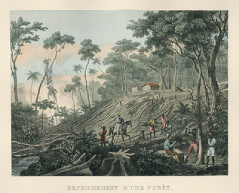March 2022
Vivian Mannheimer | Blog Historia Ciência Saúde Manguinhos

Frederico Freitas is Assistant Professor of History at North Carolina State University. His article Hunters, rangers, cougars, and jaguars: human and nonhuman territories at the Argentine-Brazilian border, 1960s-1990s is part of the dossier “Unbalanced reciprocities: the history of relationships between animals”.
In the article Hunters, rangers, cougars, and jaguars: human and nonhuman territories at the Argentine-Brazilian border, 1960s-1990s, historian Frederico Freitas explores the role of territorial practices in the interaction between human and nonhuman animals. The article focuses on the Iguazú and Iguaçu national parks, established by Argentina and Brazil in the 1930s as nature reserves bisected by an international boundary.
In this interview to the blog of HCS-Manguinhos, Freitas talks about the spatial perspective in the interaction between human and nonhuman animals and the historical importance of these parks at the border of Brazil and Argentina.
“Instead of being analogous but distinct phenomena, human and nonhuman territorialities reside at different points on the same continuum. The spatial dimensions of human and animal territoriality follow a similar geographic logic. As situated strategies of control, they inhabit a shared world.”
Can you summarize the main findings made by researchers working on the topic of your article in the past few years?
In the past decade or so, geographers have started paying attention to the types of spatial interactions established between nonhuman and human animals. They have thought about the place (physical, cultural, scientific, and epistemological) nonhuman animals occupy in human societies. They have recognized that the classificatory schemes that define nonhuman animals as “domestic,” “wild,” “feral,” “native,” “pet,” or “invasive” presuppose a placement in certain spaces. For example, “pets” are to be found in homes but not in the wild. Similarly, “wild” animals are not expected to be found in dense urban areas, except zoos. These geographers have also studied the many moments when nonhuman animals trespass, physically and epistemologically, places defined by human culture and practices.

Promotional material produced in the early days of the Argentine national park advertised “jaguar hunting” as an activity for tourists in the region (Dirección de Parques Nacionales, 1940).
What is the role of territorial practices in the interaction between human and nonhuman animals?
The exciting thing about territories is that scholars have produced a robust body of scholarship on human and nonhuman territories. Still, these are two fields that do not communicate with each other. The study of human territories is the purview of geography, political science, history, anthropology. It is the study of how power is deployed in human societies through political, cultural, legal, and social boundaries.
On the other hand, nonhuman territories are the domain of biologists, zoologists, ecologists, and ethologists, who focus on how nonhuman animals construct space through mechanisms deemed as primarily instinctual. As I argue in my article “Hunters, rangers, cougars, and jaguars,” I believe that “instead of being analogous but distinct phenomena, human and nonhuman territorialities reside at different points on the same continuum.
The spatial dimensions of human and animal territoriality follow a similar geographic logic. As situated strategies of control, they inhabit a shared world. Thus, human and nonhuman territorialities overlap spatially in ways that create opportunities for various inter-species interactions.” This is not exactly a novel position—many scholars have looked at territoriality as a dimension where human and nonhuman spaces overlap. Yet, as a historian, I tend to focus on how spatial interactions between humans and nonhumans develop diachronically in time.
What is the historical importance of these parks for Brazil and Argentina?
In my article, the Iguazú National Park in Argentina and the Iguaçu National Park in Brazil provide an interesting case study because they are located at the border between the two countries. Thus, we have a confluence of different territories and borders, which amplifies the opportunity for territorial trespassing by various human and nonhuman agents (e.g., hunters, rangers, cougars, jaguars). When it comes to the different boundaries encountered in this two-park complex, there are boundaries between park and non-park, between Brazil and Argentina, between the different park zones inside the park, and between the territories of human and animal predation.

Frederico Freitas is also the author of Nationalizing Nature: Iguazu Falls and National Parks at the Brazil-Argentina Border (Cambridge University Press, 2021)
Beyond the issue of the multitude of boundaries, the two parks also have a rich history that connects with the issue of establishing and securing the international border between the two nations, Brazil and Argentina. The two national parks were created in the 1930s as part of a push by park boosters on each side of the border to use national parks to nationalize the border. This is the history I uncovered in my recently published monograph, Nationalizing Nature: Iguazu Falls and National Parks at the Brazil-Argentina Border (Cambridge University Press, 2021), which deals with the creation and establishment of the parks between the 1930s and 1980s.
The book sheds light on a little-known but crucial aspect of these South American national parks—they were initially created to promote the settlement and development of border areas. Instead of reproducing the unpopulated landscapes found in US parks, policymakers in Argentina and Brazil designed their national parks to attract settlers to “nationalize” border zones in the 1930s.
They hoped to use parks to populate a sparsely inhabited borderland with migrants from their densely populated Atlantic seaboards. This initial model gave way, in the 1960s, to an international consensus of parks without people that compelled eviction in the name of nature preservation. This shift soon led to the removal of park settlers from Iguazú and Iguaçu and the reforestation of these protected areas. These depopulation campaigns were carried out at the height of military dictatorships in both countries, highlighting the complex relationship between authoritarian regimes, conservation, and land policy in South America.
Freitas, Frederico. Hunters, rangers, cougars, and jaguars: human and nonhuman territories at the Argentine-Brazilian border, 1960s-1990s. História, Ciências, Saúde-Manguinhos [online]. 2021, v. 28, suppl 1.
Pesquisador estuda interação entre caçadores e grandes felinos na fronteira Brasil-Argentina na segunda metade do século XX Autor de artigo em HCS-Manguinhos, Frederico Freitas, professor da North Carolina State University, dialoga com Lise Sedrez (UFRJ) e Regina Horta Duarte (UFMG) no programa Conversa Animal, no YouTube.
See full supplement:








